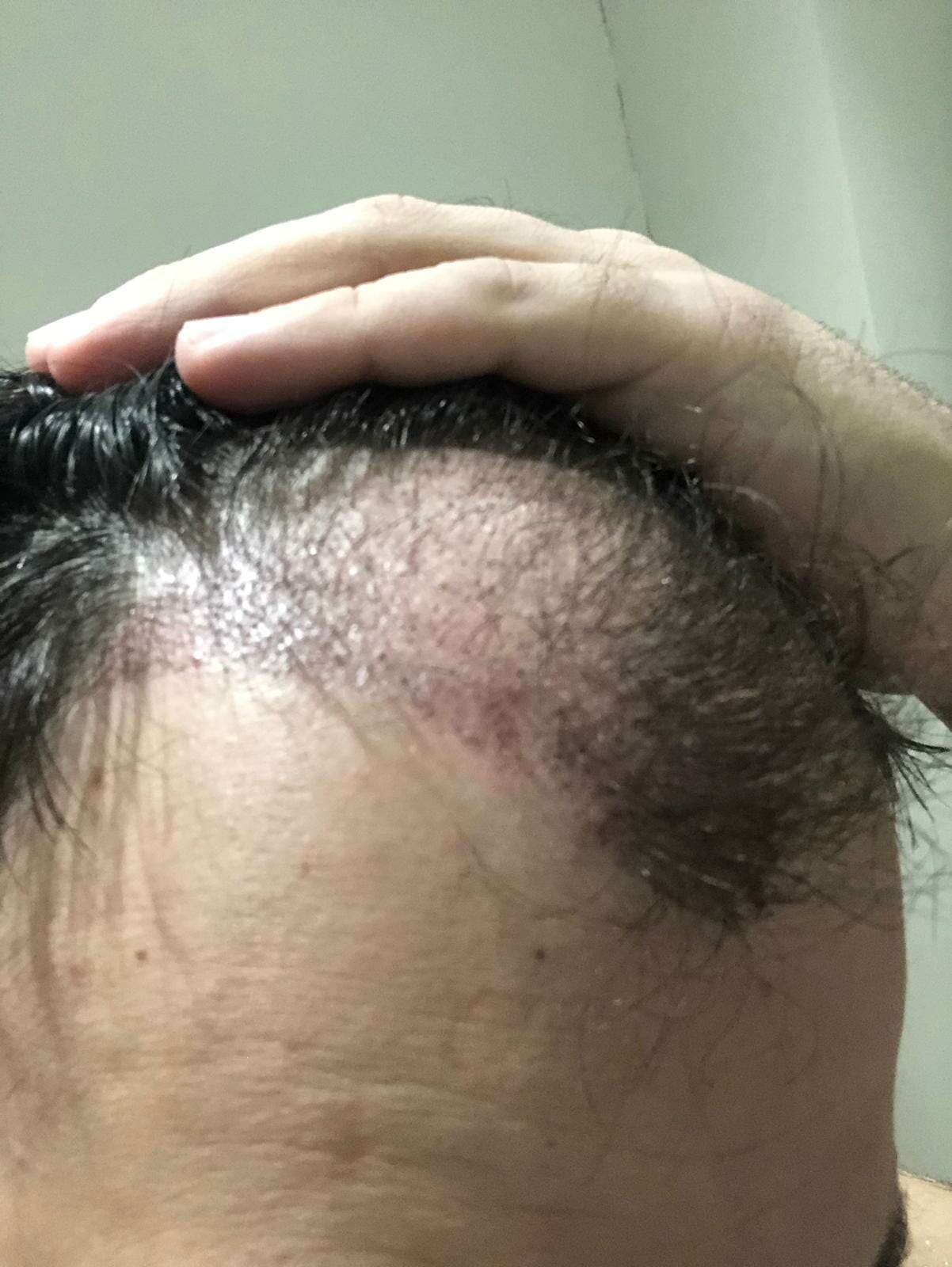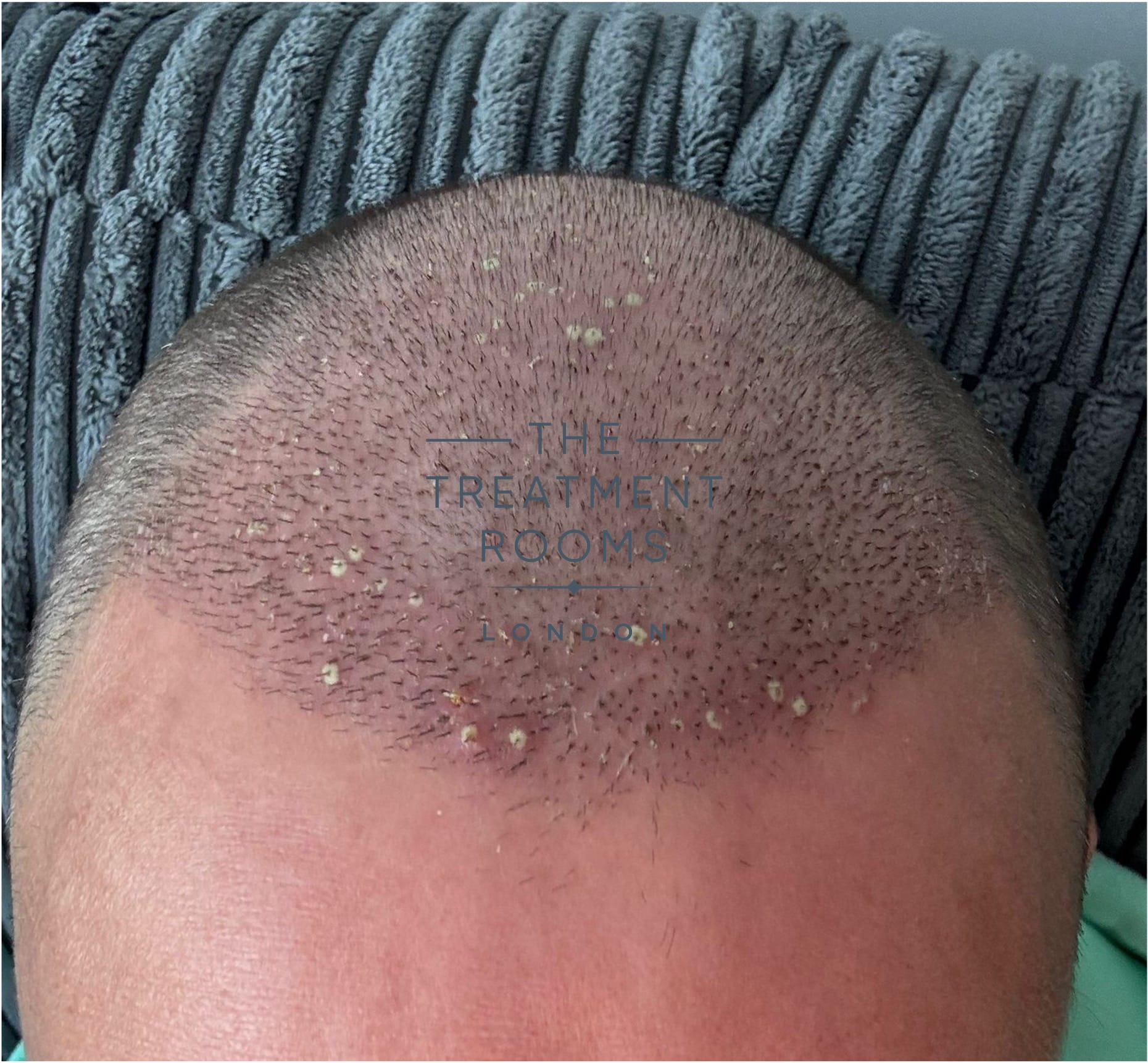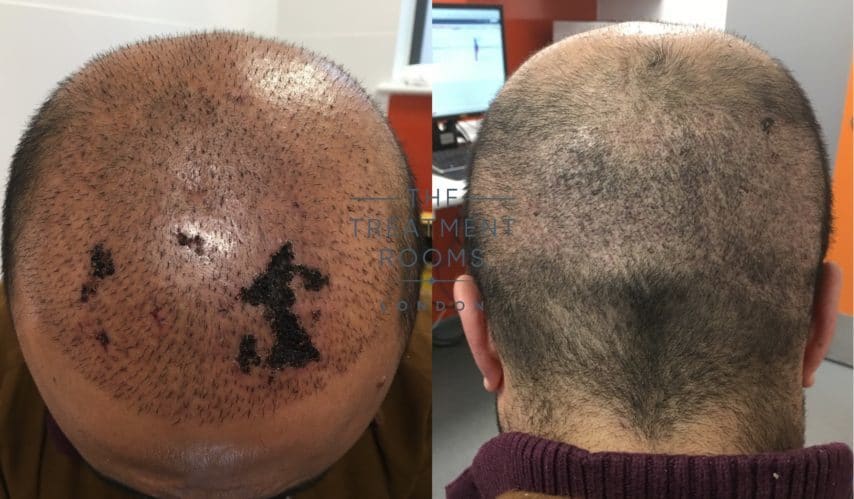What You Need To Know About Redness After A Hair Transplant
Hair transplant redness is common in the recipient area after having an FUE or an FUT hair transplant. Redness normally goes away with time but in some cases you may need treatment if there is a concern around ongoing inflammation or infection after surgery.
Redness is seen in both the skin and the scabs that form around the transplanted grafts. This blog will help you understand more about the redness and what this means for your recovery.
At The Treatment Rooms London we always like to check on our patients to see how they are recovering as part of our hair transplant aftercare programme. One of the key questions is how much redness they have after surgery?
What is redness after hair transplant surgery?
The red colour of your skin after your hair transplant can be seen at the back of your head (donor area) and where hairs have been implanted (recipient area). Also called, “erythema”, it is simply inflammation following your hair transplant and is the result of increased blood flow and immune system activity in the area that has been operated in. As surgery involves making small cuts into your skin, these cuts will start to heal at the back and around your newly implanted hair. The processes that contribute to healing cause redness and that’s why you see it.
Many hair transplant patients experience this red colour in their skin as a natural part of the healing process and usually subsides within a few weeks..

Causes of Redness
There are several factors that contribute to redness after hair transplant surgery. These include:
- Increased Blood Flow: The body sends more blood to the treated area to deliver oxygen and cells that help the scalp repair itself
- Inflammation: This is a natural immune response to the tiny incisions made during the procedure. It helps protect the area and starts the healing process.
- Sensitive Skin: Some individuals naturally have more sensitive skin, which can be more prone to redness and irritation. This is often seen in Nordic individuals with Type 1 Fitzpatrick skin type
- Skin Infection: If the scalp is not properly cared for, there is a risk of infection, which can exacerbate prolong redness and impact the hair transplant outcome.
How long does the redness last during the healing process?
Many patients may find that their redness fades after 2-4 weeks. Patients with darker skin may notice that the redness is less pronounced and fades more quickly compared to those with fairer skin.
As your scalp starts to heal the redness should reduce. Most hair transplants heal quickly within 10-14 days. However, in some large hair transplant cases this healing process can take longer- especially in patients with fairer skin tones. In such patients it can take a while and even up to 6 weeks for redness to fade.
Is a Pink Scalp Normal?
In the initial 2 weeks your scalp will appear red. This red skin tone will then reduce in shade to a pink colour. A pink scalp after hair transplant surgery is likely due to the increased blood flow in the surgical area, which is necessary for the healing process. However, if this pink tone of the skin persists or worsens, it’s essential to consult with a hair transplant surgeon to rule out any underlying complications. Persistent redness or pink scalp could indicate an issue that needs medical treatment.
Reducing Redness
There are several ways to reduce redness after hair transplant surgery. These include:
- Following a Proper Aftercare Routine: This includes gentle cleaning of the scalp and avoiding sun exposure, which can aggravate redness.
- Applying Recommended Creams or Lotions: Your hair transplant surgeon may suggest specific creams to reduce inflammation and promote healing. This will depend on whether the underlying cause is an infection or general inflammation without infection causing the redness.
- Avoiding Scratching or Rubbing the Scalp: Itching you scalp can cause further irritation and delay the healing process.
By adhering to these tips, you can help ensure a smoother recovery and reduce the redness associated with your hair transplant.
Will it affect my transplant?
Normal healing related redness should not affect your transplant. However, in some cases redness isn’t caused by normal healing and you will need to see your surgeon to check your recovery and your transplanted follicles.
- Folliculitis (hair infection)
- Cellulitis (skin infection)
- Cysts (small round swelling under the skin)
- Skin necrosis (dead and dying skin)
All the above can affect your donor area or recipient area after a hair transplant and therefore we advise you keep an eye out for them. Their common symptoms and signs are detailed below as well as our recommended treatment.
Folliculitis
Some patients may suffer from skin redness and infection around the newly implanted hair follicles. The risk of this occurring can last up to 8 months. You can see folliculitis has small red pimples forming around each hair even with a small pus (yellow) head. It can feel hot, itchy and painful. This is actually a fairly common condition after a hair transplant. The cause can be due to a bacterial infection (10%) but in many cases bacteria aren’t found (23%), (1).
Treatment is simple and effective. You can leave it alone and it will gradually resolve by itself. However, we recommend you see your surgeon to get it properly looked at. You might benefit from warm compresses or a course of antibiotics/ antibiotic cream to help fight any bacteria that could be there. Be sure to keep your scalp as hygienic as possible to prevent any further problems of infection, (2).

Cellulitis (Skin Infection)
Cellulitis involves an infection of the skin on your scalp, (3). After undergoing a hair transplant your skin is at risk of bacteria finding their way in and causing an infection. If you have cellulitis you will notice your redness may start to spread, your scalp feels painful and you may even develop a fever.
If you have these symptoms it is important you see your surgeon immediately. A course of antibiotics and daily monitoring to make sure your infection is improving should fix this problem. You will know your skin infection is getting better if the redness stops spreading and eventually disappears.
Cysts
Cysts are small circular sacks that grow under the skin. They can occur at your donor or recipient area. They are caused by a number of potential factors including grafts not being taken out of the donor area or implanted properly. Cysts can also be caused by your skin healing abnormally. You can see cysts as they swell, become red and they are painful, (1).
If you think you are suffering from cysts then please see your surgeon. Treatment is straightforward. Your surgeon may decide to take out the cyst or advise you to use warm compresses on the area. Your surgeon may choose to start you on a course of antibiotics if needed.
Skin Necrosis
Skin necrosis is a condition where you skin is dead or dying. This is a complication that should never happen as it suggests poor surgical skill by your surgeon. It looks like a deep scab on your skin and it can appear at the back of your head or where hairs have been implanted. It can appear within the first 2-4 weeks after having surgery. You may notice your skin start to look dusky or purple in colour before the skin starts to die and go black. A picture below is an example of what skin necrosis looks like.

If you notice you have any of these signs in your skin you must see your surgeon immediately. You will need to have your necrotic skin removed. The area will scar and no hair will grow there unless you choose to have fat grafting and a second hair transplant procedure.
Itching and How to Reduce Skin Redness
As we have mentioned before, itching is common after your transplant, (click here to read our dedicated blog). Itching can affect your donor or recipient area following your hair transplant. It can be treated easily and you must see your surgeon if you continue to itch after 2 weeks. Itching can delay healing and in some serious cases it can affect your hair transplant results. It is a common cause of redness after 4 weeks.

Still worried about redness after your hair transplant?
Suffering from cellulitis (skin infection)? Read hereto find out more about what the NHS recommends for treatment.
Suffering from folliculitis (hair infection)? Read hereto find out more about what the NHS recommends for treatment.
If you are experiencing uneven hair growth along with redness after your hair transplant, it is important to consult your surgeon for advice on how to manage these symptoms.
You can read more about the side effects of a hair transplant in our blog.
References
Share:
Authored by
Reviewed by
Book a Consultation
Related Blogs
Ariana Grande Hair Loss: Prevention, Styling Secrets, and Hypothetical Transplant Solutions
April 10, 2025
Ariana Grande, the global pop sensation renowned for her signature high ponytail and bold hairstyles, has openly…
Daniel Craig Hair Transplant: Before, After and His Hairline
April 10, 2025
Daniel Craig, the world-famous English actor who gained international fame as the fast-paced, debonair James Bond, has…
Rob Brydon Hair Transplant: Before, After, and His New Hairline
April 8, 2025
Rob Brydon, the beloved Welsh comedian and Gavin & Stacey star, has traded his receding hairline for…
Gordon Ramsay Hair Transplant: Before, After, and His New Hairline
April 3, 2025
Gordon Ramsay, the fiery Michelin-starred chef, restaurateur, and TV personality, has swapped his receding temples for a…
Has Perez Hilton had a hair transplant? All You Need to Know
April 2, 2025
Perez Hilton is a familiar face in the media. He is known for his work as a…
Ronnie Vint – Love Island Hair Transplant: Before, After, And His Hairline
March 31, 2025
Ronnie Vint, a former footballer and current TV personality, appeared on the 2024 season of “Love Island”…
Prince Harry Hair Loss: Speculations, Treatments, and Possible Transplant Options
March 28, 2025
Prince Harry, the Duke of Sussex and beloved royal-turned-global humanitarian, has sparked global curiosity over his ever-evolving…
Elton John and His Hair Transplant Journey
March 27, 2025
Sir Elton John has had one of the greatest careers in music. Since his rise to fame…
Elon Musk Hair Transplant: Before, After and His New Hairline
March 26, 2025
Elon Musk, the billionaire behind Tesla and SpaceX, is a well known figure for his innovations and…











